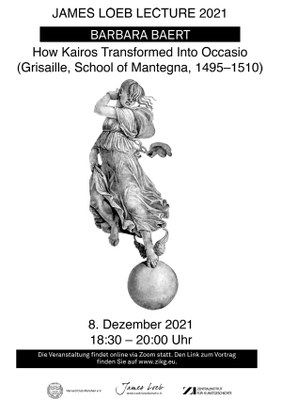Online | James Loeb Lecture 2021 // Barbara Baert: How Kairos transformed into Occasio (Grisaille, School of Mantegna, 1495-1510)
This lecture features a grisaille fresco depicting the Kairos/Occasio motif (Museo della Città nel Palazzo di San Sebastiano in Mantua). A female body with hair in front of her face and a bald crown moves with winged feet on top of a globe. Her clothing billows dynamically in the wind. She is a contrast to the woman with headgear, who has been placed on a rectangular pedestal and is keeping a young man from chasing the winged woman in motion. He stretches out his arms to her in vain.
The iconography of this grisaille crystallizes the longue durée migrations of ‘the right moment’ or the fleeting opportunity. The grisaille illuminates a historical juncture in which the Fortuna/Occasio motif fascinated families of art patrons such as the Gonzagas, Sforzas and Estes. The hybrid forms arose with the new, humanist understanding of human destiny. Likewise, the Mantuan grisaille embodies a modern depiction of mankind and its responsibility to society. The grasping of the moment in the fresco allows us to grasp what ‘opportunity’ embodied for 15th -century aesthetics and ethics (fleeing, nymphean, steady, motion, immobility, youth).
Moreover, this paper offers the first complete status quaestionis on the meanings attributed to the grisaille currently from Aby Warburg’s (1866-1929) first hypothesis in footnote 56 of his iconic article Francesco Sassettis letztwillige Verfügung (1907) to the present. My own investigations indicate that the generation of art historians in Warburg’s wake, such as interbellum scholars at The Warburg Institute in London, took particular notice of the grisaille. Early modernists like Alfred Doren (1869-1934), Edgar Wind (1900-1971) and Rudolf Wittkower (1901-1971) saw this Mantuan iconography as the crossbred symptom of a new Fortuna discourse that had arisen within Humanism. It was precisely from their interest in the broader context of neo-Platonism, of rhetoric and virtue, of political opportunism and new mercantile ways of thought, that the grisaille registered to this generation as a ‘critical moment’.
My paper aims not only to save the grisaille from oblivion; it still makes it an exemplary object of Nachleben – or Afterlife Studies – that was developed by that particular generation.
 Prof. Dr. Barbara Baert
Prof. Dr. Barbara Baert
Barbara Baert (1967) is Professor in Medieval Art, Iconology and Historiography at the KU Leuven. Her research projects show a determined interdisciplinary dialogue within the humanities and can be regarded from three main angles: the methodological space between text and image, the impact of the sensorium in the visual arts, and finally critical reflection upon her own discipline. Author of more than 80 articles, 100 chapters in books, 23 books and 16 edited volumes, Barbara Baert was honored with several awards, among which the most prestigious is the Francqui Prize for Human Sciences in 2016. In November 2017 she was knighted in recognition of her public service as Commandeur in the Belgian Order of Leopold. She was invited as a guest professor at numerous universities in Europe, Japan and the United States. Baert was Fellow at the Internationales Kolleg für Kulturforschung und Medienphilosophie (IKKM) at the Weimar Bauhaus Universität (2015), at the Istituto di Studi Avanzati at the Università di Bologna (2018), and at the Institute for Advanced Study at Princeton (2019). She is a member of the Royal Flemish Academy of Belgium, and of the Academia Europaea. She is the founder and editor in chief of four academic series, amongst others, Studies in Iconology (Peeters Publishers). Her most recent books are Fragments (a celebratory glossary of her oeuvre) (Peeters: 2018), What about Enthousiasm (Peeters: 2019), Interruptions & Transitions. Collected Essays on the Senses in Medieval and Early Modern Visual Culture (Brill: 2019), About Sieves and Sieving. Motif, Symbol, Technique, Paradigm (De Gruyter: 2019), Looking into the Rain. Magic, Moisture Medium (De Gruyter: 2021) and From Kairos to Occasio Through Fortuna (Brepols – Harvey&Miller, 2021 (at press)).
————————————
PARTICIPATION: The lecture will take place via Zoom. You can join the Zoom meeting at the following link: https://us02web.zoom.us/j/85659345839?pwd=UmFZYU0xN1NxMGJ1MjlQM054NXgvZz09. Meeting-ID: 856 5934 5839 | Password: 148258.
————————————
In addition to the James Loeb Fellowship for the Classical Tradition in Art and Architecture an annual lecture will take place in honour of the patron James Loeb, organized by the Zentralinstitut für Kunstgeschichte in cooperation with the James Loeb Society e.V. and the Harvard Club e.V. Munich. >>


